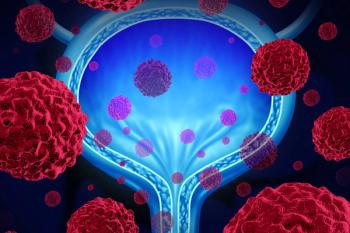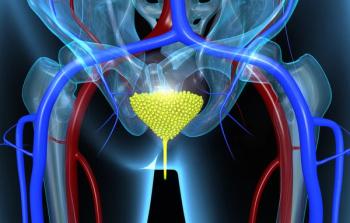
- ONCOLOGY Vol 15 No 11
- Volume 15
- Issue 11
Molecular Markers for Diagnosis, Staging, and Prognosis of Bladder Cancer
Conventional histopathologic evaluation of bladder cancer, encompassing tumor grade and stage, is inadequate to accurately predict the behavior of most bladder tumors. Intense research efforts are under way to identify and
Several important clinical observations describe thenatural history of bladder cancer and dictate its treatment:
- Most invasive bladder cancers present with muscle-invasive tumors.
- Most superficial tumors are noninvasive and stay noninvasive.
- Only 10% to 15% of superficial tumors progress to muscle invasion.
These observations lead to two central and related debates for clinicians whomust decide on how to treat an individual patient. In patients with superficialdisease, how likely are the tumors to behave aggressively? Should aggressivetherapy, such as radical cystectomy, be used as initial treatment? In patientswith tumors already known to behave aggressively (ie, those who have failedintravesical therapies or who present with lamina propria or muscle invasion),is radical cystectomy sufficient for cure or should adjuvant or neoadjuvanttherapy also be used?
Williams and colleagues describe the current state of knowledge of molecularmarkers in bladder cancer with an excellent and comprehensive overview. Theauthors document the wealth of knowledge on the molecular mechanisms by whichtransitional cell carcinomas originate and progress.
Early cytogenetic work established frequent breakpoints on chromosomes 9p,13q, and 17p that molecular methods later confirmed to exhibit a high frequencyof loss of heterozygosity. Correlation of these observations with tumor gradeand stage have suggested a clear molecular pathway for the progression ofbladder cancer: Deletions of chromosome 9 are an early event, deletions ofchromosome 5q are associated with invasion into the lamina propria, andalterations in p53, Rb, p21, and other genes controlling cell cycling areimplicated in muscle invasion and tumor growth. It is also clear that factorsregulating angiogenesis play an important role in bladder cancer pathogenesis.
Advances in the Biology of Bladder Cancer
The identification of markers of early tumor growth and progression provideda window of insight into the biology of bladder cancer and also revealed anumber of molecular targets for drug development. The exploitation of thisinformation holds real promise for the creation of new, biologically directedtherapies to supplement the empiric use of existing cytotoxics and immunologicsfor this disease.
A major challenge still remaining is the development of these markers asprognostic tools and their incorporation into clinical decision-making. Theliterature is replete with retrospective immunohistochemical studies of variousmarkers whose presence, absence, or alteration is associated with prognosis.These are important studies that generate hypotheses about biological mechanismsand may identify candidate prognostic markers, but their interpretation andclinical use are limited by differing methodologies that are not alwaysreproducible. Their retrospective nature and heterogeneity in treatment alsocould affect clinical results.
Future Clinical Studies
Exploitation of these markers as clinical tools requires that theirmeasurement be incorporated into clinical trials in a prospective fashion and,ideally, into the design of randomized trials when therapy is determined by thepresence or absence of the marker. The literature contains few examples of suchstudies, although Williams and colleagues at the University of SouthernCalifornia and colleagues at Baylor Medical College are responsible for thefirst wide-scale trial in invasive bladder cancer that will prospectively testwhether a molecular marker (p53) is useful in deciding who should receiveadjuvant chemotherapy after cystectomy (Figure1).
The development and design of this study should be a model for tests of othermarkers. It was built on retrospective observations of p53 status and clinicaloutcome after cystectomy from a large single-institution experience wherepatients were treated homogeneously and which demonstrated worse outcomes forp53-positive patients with invasive but organ-confined disease. In addition, itincorporates standardized, widely accepted, and reproducible methodology fordetermining p53 status in each case and draws on published reports on thepotential interaction of p53 mutations and response to chemotherapy. Also, itrandomly assigns patients to treatment arms based solely on their p53 status,thereby addressing an important clinical question.
Regardless of the outcome, this study represents a landmark in thetranslational science of molecular markers for the diagnosis and treatment ofbladder cancer. Studies of comparable design that address similar and unrelatedquestions with other markers should be encouraged.
There is a clear need for similar studies of markers in patients withsuperficial disease. There are several US Food and Drug Administration-approvedmarkers (eg, nuclear-matrix protein [NMP22], bladder-tumor-associated antigen[BTA], and ImmunoCyt) currently on the market for use in superficial bladdercancer. All have shown an improved sensitivity for the detection of low-gradetumors compared with standard voided cytology. However, these tools are onlyapproved for monitoring patients with a history of superficial tumors forrecurrence; they have not been tested for their ability to identify superficialtumors likely to recur or progress or to predict response to intravesicaltherapy.
Prospective studies are needed to examine these and other markers asprognosticators. The performance requirements for a useful marker differsubstantially for each clinical setting (Table1), and as the authors havepointed out, it is unlikely that a single marker will fit the bill in allcircumstances. Additional studies could identify markers that facilitatescreening of high-risk populations, help guide therapy for individual patients,and enable clinicians to decide when continued surveillance cystoscopy is safe,intravesical therapy is useful, or radical cystectomy is needed.
Molecular genetic techniques have given investigators the power to discernindividual biological steps in tumorigenesis. The challenge now is to turn theseobservations into useful clinical information with appropriately designedtrials.
Articles in this issue
about 24 years ago
Management of Pressure Ulcersabout 24 years ago
National Alliance of Breast Cancer Organizations Relaunches Websiteabout 24 years ago
Color Atlas of Clinical Hematology, Third Editionabout 24 years ago
FDA Approves Capecitabine Plus Docetaxel for Metastatic Breast Cancerabout 24 years ago
Survey Finds Women Unwilling to Pay for Immediate Mammography ResultsNewsletter
Stay up to date on recent advances in the multidisciplinary approach to cancer.

















































































